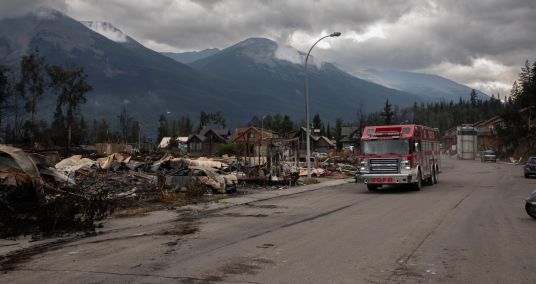Stories for you
- NewsThe Canadian Press
'We will rebuild': A look inside the wildfire devastation in Jasper
JASPER NATIONAL PARK — Richard Ireland's eyes well up with tears as he gazes in silence towards his home and sees memories of a lifetime burnt to ashes.
4 min read - NewsCanadian Press Videos
VideoControversy over Apache Christ icon shows how Indigenous tradition blends with Catholicism
A Catholic congregation in the Mescalero Reservation in New Mexico is demanding an apology after their priest removed a painting called the Apache Christ, which portrays Jesus as an Apache medicine man. (AP Video: Andres Leighton)
- NewsThe Canadian Press
New numbers confirm one-third of Jasper townsite destroyed in this week's wildfire
HINTON, ALBERTA, CANADA — One-third of all structures in the townsite of Jasper are gone, burned to the ground in this week’s wildfire, officials confirmed Friday.
3 min read - US PoliticsCanadian Press Videos
VideoDonald Trump touts his wound and goes after Kamala Harris in speech
At the Believers Summit hosted by Turning Point Action, former President Donald Trump said he took the last bandage off his ear today, for this crowd. (AP produced by Javier Arciga)
- EntertainmentCanadian Press Videos
Video'The Boys' star Karen Fukuhara celebrates her character's 'full arc'
At Comic-Con, "The Boys" star Karen Fukuhara celebrated the 'full arc' of her "The Boys" character Kimiko Miyashiro, who started the satirical superhero series mute and speaks for the first time in the season four finale. (July 26)
- NewsCBC
N.B. Public Health issues exposure notice after confirmed measles case in Moncton
A confirmed case of measles in Moncton has prompted New Brunswick Public Health to issue a list of times and places where people could have potentially been exposed to the contagious disease.In a news release issued Friday night, the Department of Health said the case is likely the result of recent international travel.The release does not say which country the patient recently travelled from or what their age is.The list of exposure locations includes:Montreal's Pierre Elliott Trudeau Internati
3 min read - BusinessCBC
B.C. Tree Fruits Cooperative shutting down after 88 years
After operating in the Okanagan Valley for nearly nine decades, the B.C. Tree Fruits co-operative announced to growers on Friday it is dissolving and seeking court direction to liquidate its assets.The co-operative, which is made up of more than 230 farming families, is perhaps best known to consumers for its green leaf logo that has adorned fruit packaging and apple stickers for decades as a sign of quality, B.C.-grown fruit. Members have been informed by email that as of Friday, the co-operati
4 min read










